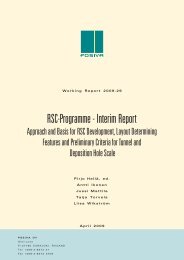Results of Monitoring at Olkiluoto in 2006 - Environment (pdf) - Posiva
Results of Monitoring at Olkiluoto in 2006 - Environment (pdf) - Posiva
Results of Monitoring at Olkiluoto in 2006 - Environment (pdf) - Posiva
You also want an ePaper? Increase the reach of your titles
YUMPU automatically turns print PDFs into web optimized ePapers that Google loves.
21Biomass <strong>of</strong> FloraThe biomass <strong>of</strong> terrestrial veget<strong>at</strong>ion was estim<strong>at</strong>ed for the <strong>Olkiluoto</strong> Biosphere DescriptionReport (Haapanen et al. 2007) by the F<strong>in</strong>nish Forest Research Institute. Twodifferent ways were used: Stand-based estim<strong>at</strong>ion, where the volumes for VCP units by Rautio et al.(2004) were converted to biomass us<strong>in</strong>g Biomass Expansion Factors (BEF) byLehtonen et al. (2004a) and understorey biomass models by Muukkonen andMäkipää (<strong>2006</strong>). Tree-based estim<strong>at</strong>ion, where the s<strong>in</strong>gle tree d<strong>at</strong>a measured from the FET plots(Saramäki & Korhonen 2005) was converted to biomasses us<strong>in</strong>g models byMarklund (1988), except for f<strong>in</strong>e roots, the biomass <strong>of</strong> which was calcul<strong>at</strong>ed accord<strong>in</strong>gto Helmisaari et al. (2007), and for leaves (models cre<strong>at</strong>ed <strong>in</strong> FFRI byJaakko Repola and Risto Ojansuu). Biomass <strong>of</strong> coarse roots and stumps <strong>of</strong> deciduoustrees were estim<strong>at</strong>ed us<strong>in</strong>g Marklund's (1988) models for p<strong>in</strong>e. The understoreyveget<strong>at</strong>ion coverages <strong>of</strong> the FEH plots were converted to biomassesus<strong>in</strong>g models cre<strong>at</strong>ed <strong>at</strong> the F<strong>in</strong>nish Forest Research Institute (Maija Salemaa).The carbon content <strong>of</strong> veget<strong>at</strong>ion was assumed to be 50% <strong>of</strong> dry mass. Net production<strong>of</strong> the tree layer was calcul<strong>at</strong>ed us<strong>in</strong>g measured growth estim<strong>at</strong>es (d<strong>at</strong>a from Rautio etal. 2004) and BEFs by Lehtonen et al. (2004a). Net production <strong>of</strong> ground veget<strong>at</strong>ionwas estim<strong>at</strong>ed with turnover r<strong>at</strong>es (Muukkonen & Lehtonen 2004). Litter productionestim<strong>at</strong>es are based on turnover r<strong>at</strong>e coefficients <strong>of</strong> biomass compartments (Lehtonen etal. 2004b, Muukkonen & Lehtonen 2004, Starr et al. 2005, Liski et al. <strong>2006</strong>,Muukkonen & Mäkipää <strong>2006</strong>).Accord<strong>in</strong>g to the calcul<strong>at</strong>ions by stands (VCP) the biomass <strong>of</strong> terrestrial veget<strong>at</strong>ion <strong>in</strong>the stands varied between 0.14 and 28.4 kg/m 2 , mean value be<strong>in</strong>g 7.3 kg/m 2 . Accord<strong>in</strong>gly,carbon content varied between 0.07 and 14.2 kg/m 2 , and the highest values wereobserved <strong>in</strong> the N<strong>at</strong>ura conserv<strong>at</strong>ion area (Fig. 13). The mean carbon content <strong>in</strong> Scotsp<strong>in</strong>e, Norway spruce and deciduous stands was 0.8, 1.2 and 1.5 kg/m 2 , while the maximumcarbon content was 9.1, 9.9 and 11.7 kg/m 2 , respectively. The correspond<strong>in</strong>g valuesfor understorey veget<strong>at</strong>ion were mean 0.13 and maximum 0.32 kg C/m 2 . The totalcarbon content was 24,139 Mg <strong>in</strong> the terrestrial veget<strong>at</strong>ion <strong>of</strong> the stands on the <strong>Olkiluoto</strong>Island. Based on FET plot measurements, the highest mean carbon content 10.2kg/m 2 was found <strong>in</strong> 81–100-year-old spruce-dom<strong>in</strong><strong>at</strong>ed forests (Table 10). Mean carboncontent <strong>in</strong>creased from young and <strong>in</strong>fertile sites to more fertile and older ones (Table11). On average, the stem with bark accounted for 43, branches for 22, foliage for 15,stump for 5 and roots for 15% <strong>of</strong> the total tree biomass on FET plots. The amount <strong>of</strong>carbon bound <strong>in</strong> ground veget<strong>at</strong>ion was clearly less than <strong>in</strong> trees (mean value 0.10kg/m 2 , Tables 12 and 13).The comb<strong>in</strong>ed net production <strong>of</strong> the trees and understorey veget<strong>at</strong>ion varied from 49 to763 be<strong>in</strong>g on average 302 g C/m 2 /a (Fig. 14). Estim<strong>at</strong>es <strong>of</strong> annual fluxes <strong>of</strong> net production(growth) and litter production by dom<strong>in</strong>ant tree species are presented <strong>in</strong> Tables 14and 15.
















